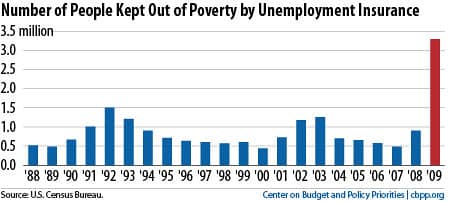The Good, the Bad and the Ugly of the Poverty Data
To be sure, the new Census data on poverty and health care in America are grim. At 14.3%, the poverty rate in 2008 jumped to its highest level since 1994. Meanwhile, the number of uninsured catapulted to 50.7 million, as employers shed jobs and insurance benefits during the deep Bush recession. Ominously, median household income dropped to $49,777, a 4.8% decline between 2000 and 2009. But as bad as the news was, it is both better - and worse - than the headlines suggest.
The silver linings, if they can be called that, come in two flavors. One, as the Wall Street Journal among others noted, is definitional. As University of Chicago economist Bruce Meyer noted, the poverty rate (now set at $21,756 for a family of four), "misses most of the programs that have been added or expanded in the last 20 years to reduce poverty":
But this only takes into account monetary income, while omitting the many benefits that now form the backbone of the government efforts to lift the poor. Such programs include subsidized housing and the Earned Income Tax Credit...
For instance, the government estimates if the food stamp program was counted, it would have lifted 3.6 million people above the poverty threshold last year.
(As the New York Times detailed in November, "With food stamp use at record highs and climbing every month, a program once scorned as a failed welfare scheme now helps feed one in eight Americans and one in four children.")
The other bright spot is that recession-fighting programs put in place by President Obama and his Democratic allies prevented a dire situation from being much worse. As the CBO and former McCain economic adviser Mark Zandi each documented, the Obama stimulus program alone added up to 2.8 million jobs and 4.1% to GDP by the first quarter of 2010. And the impact of the total array of federal programs averted, Zandi and former Fed vice chairman Alan Blinder insisted, prevented the Great Recession from becoming Depression 2.0. As the New York Times reported in August:
In a new paper, the economists argue that without the Wall Street bailout, the bank stress tests, the emergency lending and asset purchases by the Federal Reserve, and the Obama administration's fiscal stimulus program, the nation's gross domestic product would be about 6.5 percent lower this year.
In addition, there would be about 8.5 million fewer jobs, on top of the more than 8 million already lost; and the economy would be experiencing deflation, instead of low inflation.
Near the top of the list in poverty-prevention bang for the buck has been unemployment benefits. While Republicans tried and ultimately failed to block jobless benefits they called "welfare" (Newt Gingrich), "unconstitutional" (Joe Miller) and worse (Sharron Angle), unemployment insurance kept 3.3 million more people out of poverty in 2009. As an analysis from the Center on Budget and Policy Priorities (CBPP) concluded:
In other words, there were 43.6 million Americans whose families were below the poverty line in 2009, according to the official poverty statistics, which count jobless benefits as part of families' income. But if you don't count jobless benefits, 46.9 million Americans were poor.
As alarming as the health care numbers from the Census Bureau are, Democratic initiatives again prevented the worst case scenario. The Recovery Act's bolstered federal Medicaid and COBRA subsidies, along with the expanded State Children's Health Insurance Program (SCHIP) also opposed by the GOP, enabled coverage for millions of Americans. And looking ahead, the Affordable Care Act passed by Democrats this spring will take a significant bite out of the massive and growing pool of those in America without health insurance. Having added over four million just since the start of the Bush recession in late 2007, the ranks of the uninsured will be reduced by 32 million as a result of the Obama health care law. Still, the individual insurance mandate, new exchanges and federal subsidies don't kick until 2014. As Helen Darling, president of the National Business Group on Health lamented, "But that's four years away, and there's going to be a lot of financial pain and economic burden before."
(Still, a Republican Party unconcerned by the swelling numbers of uninsured is debating only how, not whether, to replace the Affordable Care Act.)
But the ugliest message in the poverty data may be among the least discussed. While income inequality was reaching record levels in 2007, the poverty rate was already rising before the Bush recession began in December of that year.
Writing in the Washington Post last week, Ezra Klein wanted to "draw your attention to the scariest numbers in the release, even though they're not from this year." Pointing to deeper, structural problems for the U.S. economy even in comparably good times, Klein warned:
We've seen a big jump in the poverty rate in the past two years, of course, but we also saw a mild increase in the years before that. Between 2001 and 2007, the poverty rate increased from 11.7 percent to 12.5 percent. But the economy grew in every one of those years. This was the first period since we began keeping records in which the economy expanded but poverty went up -- usually, economic expansions bring the poverty rate down. It's more evidence that the pre-crisis "normal" was an economy that wasn't working very well for a lot of people, even when it was growing.
It's no wonder Klein called it "one of my least favorite graphs."
As it should be. After all, in a Census Bureau poverty report that contained little good and much bad, this picture was the ugliest of them all.




I'm with Ezra Klein. That second graph is a horror story.